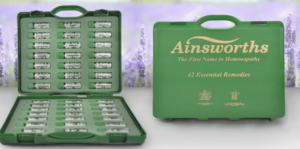
Are there homeopathic remedies for a sore throat? Indeed there are. If you follow this blog you will know that Classical Homeopathy follows the ‘law of similars’. Simply put this means that the characteristics of the ailment as experienced by the patient must match the ‘picture’ of the remedy (homeopathic medicine).
Many homeopathic remedies have a sore throat ‘picture’. Fortunately, there is overlap between the various remedies such that absolute precision is not required.
Continuing with the series on remedies in a typical home first aid kit, in this blog I focus on kit remedies that have a particular affinity to sore throats. For more on the benefits of purchasing a first aid kit of basic homeopathic remedies see my earlier blog Family Care with Homeopathy

Classical homeopathic prescribing for acute complaints considers the following:
A sore throat is a blanket term for inflammation or infection affecting the tissues of the throat. Typically affecting the tonsils and adenoids. These specialised tissues are part of the immune system which guard the airway (Pharnyx). Sometimes there is a loss of voice if the infection spreads to vocal box/chords (Larynx) located below the Pharnyx. The diagnosis reflects the location, hence Tonsilitis, Pharyngitis, and Laryngitis.
The offending microbe is often a virus, but it can be a bacterium (hence “Strep” throat).
Wikipedia gives a good overview on the orthodox treatment of tonsilitis.
The typical symptons of pain on swallowing, swollen tonsils, a dry throat and possibly fever are doubtless familiar. The formation of an abcess behind a tonsil is known as Quinsy and is particulary unpleasant and may make jaw movement painful.
Most sore throats self-resolve in a week or so. A course of antibiotics is the orthodox treatment (where the cause is bacterial) and should always be considered in urgent cases. If there is severe pain with significant difficulty swallowing or difficulty breathing NHS guidance is to go to A&E.
However, a well selected homeopathic medicine can usually reduce the duration of any infection.
By the way, it is perfectly possible and appropriate to take homeopathic medicines alongside orthodox treatment. Homeopathic medicines function in a different way to antibiotics or analgesics (pain killers). There is no conflict and in this context they are indeed complementary.
Homeopathic medicines are neither antibiotic or antiviral in the conventional sense. Rather they stimulate the immune system of the body to overcome the infection.
We need to be midful of antibiotic resistance and use our antibiotics appropriately.
If you suffer from recurring throat infections, this is probably a sign that your body is struggling to restore and maintain good health. Professional homeopathic care can assist your body’s own defences, increasing resilience and breaking the cycle of repeated infections. In homeopathy we call this Constitutional Treatment.
If you want to discuss this further, you can book a free 30 minute discovery call with me here.
Described below are ten of the homeopathic remedies useful in sore throats which you will find in most homeopathic first aid kits. The one which will engage your body’s healing process is the one which most closely matches your specific symptoms.
Consider every homeopathic medicine a ‘key’. If it fits the ‘lock’ you will get some improvement in a couple of hours. Falling asleep is a good sign of healing taking place.
If there is no improvement, there is no harm whatsoever in trying another remedy. As sore throats share characteristics, matching the general characteristics of the remedy may best aid selection.
The first three (Aconite, Belladonna and Apis) I have written about before in more general terms.
These two remedies are similar – yet different. Both can have an associated with high fever.
Aconite is often the remedy to give in the early stages of infection when the onset of symptoms is sudden. A typical cause if becoming chilled when hot.
The general characteristics of Aconite are fear, restlessness and anxiety.
The onset of symptoms is sudden; within just a few hours of exposure to the cause. The throat, it is dry, very red and constricted. Cold drinks bring some relief. There is an initial affinity for the left side (e.g. left tonsil).
The general characteristics of Belladonna are heat, redness, throbbing and burning. In a word violence. Children have high vitality which means that their immune systems respond accordingly (i.e. violently!). Belladonna is a ‘must have’ children’s remedy.
The onset of symptoms is somewhat slower than that for Aconite. Though hot, the patient feels chilly and wants to be covered (‘Aconite’ prefers the cool air).
There is anger / irritability and the affinity is for the right side (contrasting Aconite). The patient is not so thirsty but may take small sips of water (lemon flavour appeals) to ease the dry throat and the continual desire to swallow.
Apis is a homeopathic medicine made from the venom of the bee.
The general characteristics of Apis match with the effects of a bee sting: burning-stinging pain and swelling.
This is a medicine for highly inflamed and swollen tonsils, perhaps with ulceration. Swallowing is difficult. Patients are not especially thirsty but sucking ice cubes may help. This patient is restless (think ‘busy bee’).
p.s. It is also a useful medicine in urinary tract infections (along with Cantharis)
The general characteristics of Bryonia are dyness (‘DRY-BRY’), great thirst, worse for movement and better for rest. The Bryonia patient can be irritable.
The onset of illness in the Bryonia patient is slower. Perhaps 24 or 48 hours after exposure to the cause, which may be damp or autumn weather (hot days / cold nights).
This slower onset reflects the lower vitality of the patient. Where the Belladonna picture often matches the child, Bryonia is more suited to the adult. Soon there is much catarrh. Compared to Aconite, Belladonna and Apis the throat has a duller hue.
The general characteristics of Gelsemium are dizziness, drowsiness and dullness. A state of apathy and weakness (‘Worn-out’).
These characteristics often match the influenza picture. Again the onset is slower. The tonsils are red and swallowing is difficult due to muscular weakness. There is itching in the palate and nose and a sense of a lump in the throat. The voice may be weak either from the nervous state or catarrh.
(p.s. My son at about age 4 – now 34! – responded almost instantly to this remedy. I had previously tried Belladonna to nil effect and was on the cusp of calling the doctor.)
The general characteristics of Hepar Sulphuris are suppuration and hyper-sensitivity (cannot bear the affected part to be touched). This is reflected in the impulsive mental state (‘touchy’).
This is a remedy where the tonsils and glands are swollen, possibly with pus and the throat feels constricted. There is a very typical sharp, stitching, splinter-like pain in the throat (described as a stuck fishbone or like swallowing broken glass), which often affects the ears when swallowing. The throat is sensitive to touch and cold. The symptoms are relieved by hot drinks.
The general characteristics of Lachesis (from a snake venom) are loquacity (talks constantly), suspicion and again great sensitivity to touch. The collar must be very loose.
This is a remedy for Quinsy with ulcerated tonsils. The throat of the Lachesis patient is dry and has a purplish colour. The onset of symptoms is on the left side and the pain extends up into the ear. There is an inability to swallow and a curious feature that liquids cause more difficulty in swallowing than solids. Another curiosity is that symptoms tend to worsen after sleep.
The general characteristics of Merc.sol. (as typically abbreviated) are seen in the metal of the same name; the only metal that is liquid at room temperature. It reacts to temperature (mercury thermometer) and is generally unstable (trembling).
This is another remedy for Quinsy. The sore throat requiring this medicine is putrid, swollen bluish-red, perhaps with ulceration and pus. Despite the pain, saliva must be swallowed. There is a metallic taste in the mouth. Much perspiration is another feature.
The general characteristics of Lycopodium are careful, cautious, conscientious. There is apprehension with a certain lack of confidence, and a tendency to digestive troubles and flatulence.
Lycopodium throats tend to begin on the right side with swelling, suppuration and ulceration (which can affect the voice). There may be sensation of a ball in the throat. The patient is better for warm drinks.
The general characteristics of Silica are a yielding nature, with weakness and poor assimilation of nutrients. Ulceration with poor healing may result. There is great sensitivity, anxiety and touchiness.
This is a remedy for a severe type of tonsilitis where swallowing is very difficut, causing a cough. Abcesses may form yet not suppurate, ot not heal. There is a left sided affinity. The patient is chilly but desires cold food. It is a remedy that is complementary to Hepar. sulph and Merc.sol and may follow these medicines where the symptoms have not fully resolved.
****
If you regularly suffer from sore throats (or have one now that is not resolving) and wish to see if homeopathy can assist, please contact me here